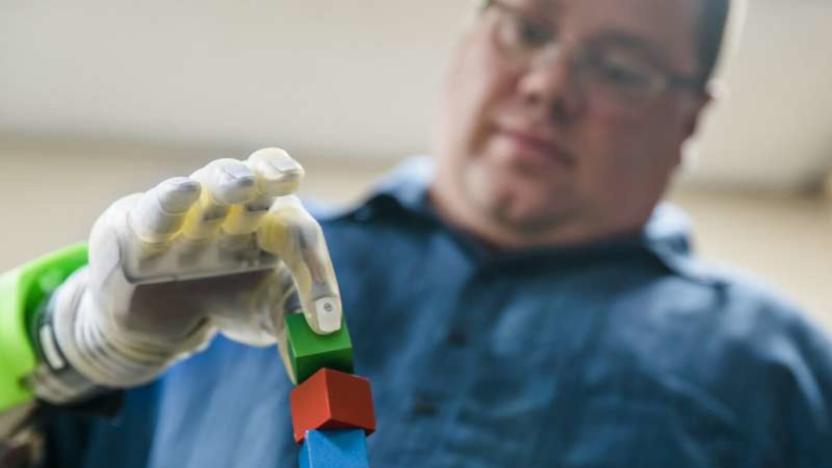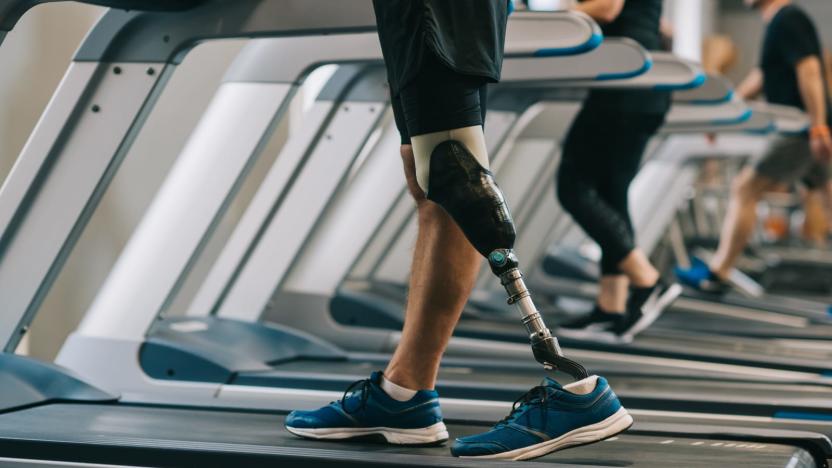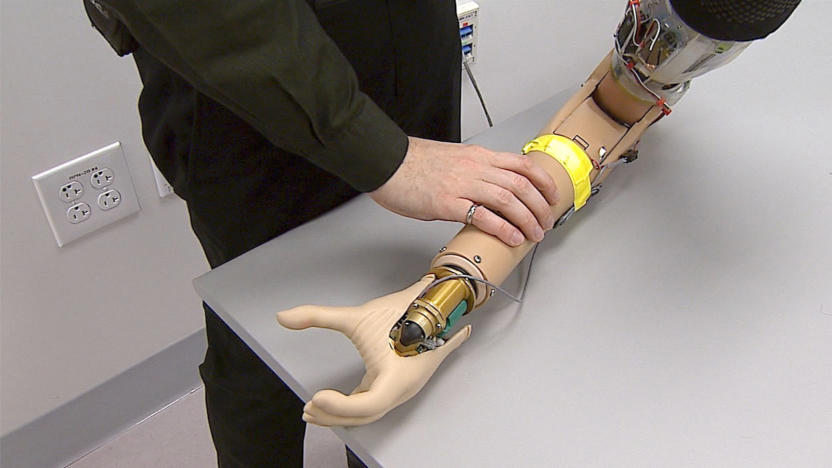amputee
Latest

MIT developed a low-cost prosthetic hand that can help amputees feel again
In a joint project with Shanghai Jiao Tong University, MIT has designed a neuroprosthetic that costs about $500 to build.

Scientists develop neuroprosthetic tech that amputees don't need to learn
For those working in the field of neuroprosthetics, the ultimate goal is to give amputees with artificial limbs natural, intuitive and real-time movement. Indeed, advances in the field have led to mind-controlled systems and even those that create kinaesthetic feedback, but so far such technologies require a great deal of learning and practice by the amputee. Now, however, scientists from the University of Michigan have developed a neuroprosthetic technology that restores intuitive movement to amputees from the get-go -- no learning required.

New prosthetic legs let amputees feel their foot and knee in real-time
There's been a lot of research into how to give robots and prosthesis wearers a sense of touch, but it has focused largely on the hands. Now, researchers led by ETH Zurich want to restore sensory feedback for leg amputees, too. In a paper published in Nature Medicine today, the team describes how they modified an off-the-shelf prosthetic leg with sensors and electrodes to give wearers a sense of knee movement and feedback from the sole of the foot on the ground. While their initial sample size was small -- just two users -- the results are promising.

AI-tuned robotic knee helps amputees walk within minutes
Amputees who receive robotic limbs can't usually start using them right away. It typically requires hours of manual tweaks to adapt to their particular movement styles, and they may need to come back for more if anything changes. Soon, however, they might only need the briefest tweaks to get moving. Researchers have crafted an AI system that can tune a robotic knee (not pictured) to allow walking on level ground within 10 minutes. It uses a trial-and-error algorithm to recognize patterns in sensor data, set initial safety limits, and learn patterns that match stable, smooth walking motions.

Brain interface adds sense of presence to bionic limbs
It's been possible for a while to control bionic limbs with your brain, but there's been something missing: kinesthetic feedback, or the nervous system signals that give your limbs a sense of presence. You frequently have to stare at your artificial arm to ensure that you're grabbing a cup instead of operating on instinct. That elusive quality may soon be a regular staple of prosthetics, however. Researchers have developed a neural interface that generate this feedback and make bionic feel like they're part of your body.

Super-precise artificial hand uses smart wires as muscles
As a rule, bionic hands are clunky contraptions made of motors, pneumatics and other machinery that just can't be as elegant as the real thing. Germany's Saarland University might just change that, however. Its researchers have developed an artificial hand that uses smart nitinol (nickel titanium) wires as its muscles. All you do to make them flex is heat them up or cool them down -- the metal 'remembers' its original shape before you bend it, so you don't need bulky equipment to move it back and forth. The wire bundles are as thin as cotton, but they're very strong and can move with much more precision and speed than usual. They don't even need sensors, since electrical resistance in the wires themselves is enough.

Antler-inspired prosthetic merges with your bone to feel like a real limb
Someday, robotic prostheses and exoskeletons might be so commonplace that amputees will no longer have to use something that resembles a suction cup on a stick. In the interim, though, there's ITAP. The technology, which stands for intraosseous transcutaneous amputation prosthesis, is a type of prosthetic that plugs right into an amputee's bone. This allows them to actually feel that artificial limb and walk like they normally would with two healthy legs, and it also prevents chafing and skin issues common among those who use prostheses. For ITAP to organically merge with one's bones, its creators from the University of London and the Royal National Orthopaedic Hospital drew inspiration from deer antlers. Like antlers, the metal part sticking into the bone is porous, inviting soft tissue to invade it and seal any surface or opening that could be infected by bacteria.

FDA approves a life-like prosthetic arm from the man who invented the Segway
After years of testing, the FDA today approved a new type of prosthetic arm that its makers claim will bring a whole new level of control to amputees. Known as the "Luke" arm or DEKA Arm System, Segway inventor Dean Kamen has been involved in its development and unlike existing prosthetics, it can understand multiple commands at once, giving its wearers "near-natural" control of the limb. As demonstrated in the videos embedded after the break, tests show wearers can get back to easily performing tasks like using keys and locks, brushing their hair, removing papers from an envelope, or picking up an egg without breaking it. While we've seen demos using other mind control techniques, the one approved for sale does its magic with electromyogram (EMG) sensors activated by the wearer contracting muscles close to where the prosthesis is attached or on their feet, which an embedded computer translates into movement.

Researchers take one step closer to neural-controlled bionic legs for safer mobility
We've seen our fair share of prosthetic arms and computer interfaces operated with little more than the firing of a synapse, but legs? They're a different story: balancing and propelling a sack of (mostly) flesh and bone is a much more complicated task than simply picking up a sandwich. Thankfully, the Rehabilitation Institute of Chicago's Center for Bionic Medicine is now one step closer to thought-controlled lower-limb prosthetics. As pictured here, the researchers' early simulations showed that amputees could control a virtual knee and ankle with 91-percent accuracy, by way of pattern recognition software to interpret electrical signals delivered through nine different muscles in the thigh -- patients think about moving, thus lighting up the nerves in varying patterns to indicate different motions. The ultimate goal is to hook up bionic legs through the same way, which would offer a greater range of motion than existing prosthetics, making tasks like walking up and down stairs safer. Now all we need is a quadruple amputee willing to pick up a badge and slap on an eye-tracking microdisplay.

Power Knee motorized prosthetic officially available in US, Europe -- race of cyborgs still in infancy
We reported on Ossur's robotic prosthetic back in 2009, and now amputees in Europe and the United States have become the first official recipients of the Power Knee. According to the company, "the world's first and only motor-powered prosthetic knee" was recently approved for reimbursement by the German National Health System, covered by private insurance in France and the UK, and picked up by select healthcare providers in the US. Power Knee combines "artificial intelligence," motion sensors, and wireless communication to learn and adjust to the walking style of its users -- that's one small step for real-life cyborgs and one giant leap for prosthetic technology.

Energy-recycling foot makes it easier for amputees to walk
What's better than an artificial nose? Why, an artificial foot, of course! University of Michigan researchers have developed a new prosthetic foot that could one day make it much easier for amputees to walk. Put simply, this new prototype drastically cuts the energy spent per step, as it harnesses the energy exerted when taking a step and enhances the power of ankle push-off. The device is able to capture dissipated energy, and an inbuilt microcontroller tells the foot to return the energy to the system at precisely the right time. Tests have shown that those using this here foot spent just 14 percent more energy to walk than one would spend when walking naturally, which is a rather significant decrease from the 23 percent uptick experienced with conventional prostheses. If you're still baffled, there's a pretty wicked video demonstration waiting for you after the break. %Gallery-86121%

Double-amputee New Zealander has mermaid dreams fulfilled
New Zealander Nadya Vessey -- who lost both of her legs to the knee when she was a child -- has just received a prosthesis that's pretty much unlike anything we've ever seen (outside of Splash). About two years ago, she approached Weta Workshop, who specialize in design and manufacturing of costumes and special effects (and have worked on projects such as The Lord of the Rings trilogy) to see if the company might be interested in making her a working, prostethic mermaid tail. Turns out they were, and they've just completed the final product. The tail, which is composed of wetsuit fabric and plastic molds, with a custom paint job and digitally-imaged effects, enables Nadya to swim quite effectively, apparently, and is an all around sexy piece of machinery. No word on what one of these slick dudes would cost in real life, but we have a feeling we couldn't justify the expense just to tool around in the kiddie pool.Update: Check out the video after the break![Thanks, Pyper]








